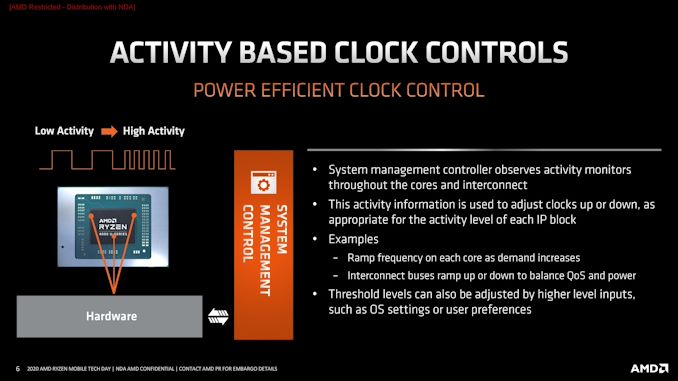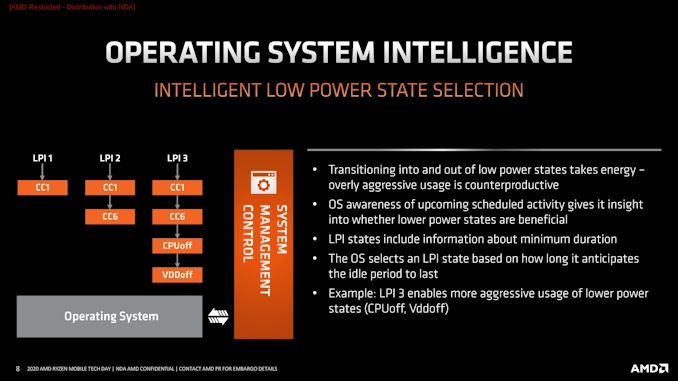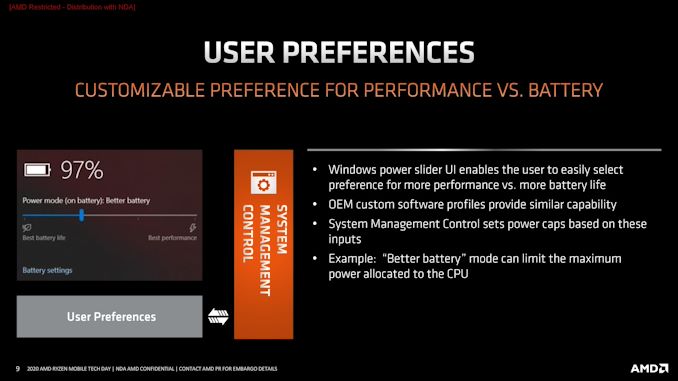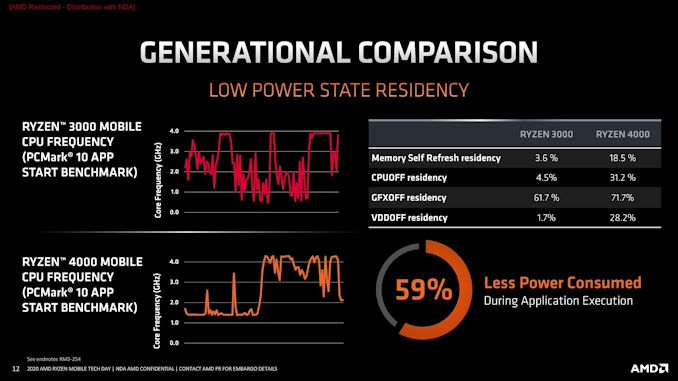AMD Details Renoir: The Ryzen Mobile 4000 Series 7nm APU Uncovered
by Dr. Ian Cutress on March 16, 2020 11:00 AM ESTPower and Battery Life
Earlier in the year AMD was keen to promote that in Renoir it has made significant advances as to how power is managed across the APU, leading to increased performance and better battery life. The two key figures here were ‘20% reduced SoC power’ and ‘5x reduction in power gating latency’ (also known as an 80% reduction, because you can’t have a 5x reduction of a time). We now have some details.
First up it should be mentioned that 7nm helps a lot here. The smaller process node, with smaller transistors (assuming they’ve been laid out correctly), will require a lower voltage. That lower voltage directly translates into lower power, and we’ve seen how well AMD has pushed the 7nm designs on the desktop and in the enterprise space to know that compared to previous process nodes, there is a lot of power to save here. That being said, the design choices and features matter too.
AMD’s power management all goes through a system-level management controller. For this generation, AMD has re-written the firmware with speed in mind (they claim 33% faster), but also made other improvements, such as aggressive clock gating of the L3 cache when not needed, and using power optimized circuits for IO features such as for the embedded display controller and PCIe physical layers.
The updated system management controller (SMC) is built around user preference. In this case if the user tells the OS he or she wants more performance, or more battery life, then the SMC can take into consideration everything involved in the system and plan accordingly. If the OS can provide guidance as to an upcoming workload, then voltages and frequencies (or parts of the chip unused can be put in idle), then the SMC is built to understand it.
Ultimately there are many sensors around the APU, monitoring activity and the type of activity going on in that particular region, even down to the types of instructions being used. The SoC is a lot more dynamic in its clock control, allowing for different clock domains in various parts of the SoC to be adjusted depending on both the activity of the region but also the thermal limits, system limits, and other items that might affect performance. This is especially useful for powering down parts of the SoC that are not in use, leading to AMD’s efficiency claims, or the performance claims such as maintaining a specific bandwidth across an interconnect (quality of service). The thresholds for these activity monitors can be set by the OS and by the user. The SMU also takes into account the power source (battery vs power supply) and connected hardware (displays, power over USB).
For the power gating latency, AMD has doubled the save and restore bus width from the buffers to the cores, allowing for a system to resume faster from a CPUOFF state. Not only this, but AMD is using the ACPI 6.3 specifications to take advantage of offering multiple C states in the OS.
One of the issues of the previous generation of Picasso APUs, on the left, is that there was only a single set of states that the processor could be in. This means that at any time, the CPU could fall from a power state (a P state) into a lower power state, or an idle state, or an off state. If the CPU went too far down this stack, while it would be saving power, each hop down the rabbit hole meant a longer time to get back out of it, diminishing performance and latency but also requiring more power changes at the silicon level. Each hop in its own right requires additional power.
With the new Renoir designs, a system can take advantage of multiple different sets of states. This means that the CPU can’t go down too low when the system is in use. With a system in use, the OS or system controller can’t put parts of the core into low power states because those are not available, which means that even if the system goes into the lowest power mode possible, while the system is still being used, then there are fewer jumps to get back up to high speed.
As the system becomes less used, known as ‘increased idle duration’, then the system has access to sets of states that allow the parts of the APU to enter deeper idle states. This means that the system can only enter a low frequency domain if that part of the core has been sufficiently idle, or user interaction has willed it.
This is all part of the ACPI 6.3 standard, and AMD states that this combined with the reduced SoC power gives both better battery life and better immediate performance for the user. To show this in action, AMD pinpointed a common activity that most users might be familiar with: opening applications.
In this case, AMD took the start of the PCMark 10 Application Loading benchmark. In this benchmark a number of applications are loaded, and the requirements are often more IO driven than CPU driven. A good CPU with a fast reaction time will keep its power and frequency low while the IO requests are being done, and speed up one or two threads when the CPU needs to get involved.
In AMD’s benchmark, where they are using frequency as a proxy for power, They show that in the initial 5 seconds of the test, the new Ryzen 4000 CPU is hovering at an idle frequency, whereas the older Ryzen 3000 CPU is fluttering around, even peaking near 4.0 GHz when it doesn’t need to. This allows parts of the new CPU to be powered down for longer periods of time, even when the system is actually in use.
When I asked AMD’s executives where they stand on battery life, one of them hinted that the difference between themselves and the competition (in similar designs) should be on the order of minutes rather than dozens of minutes. Specifically AMD sees itself better than the competition in productivity/web browsing workloads, graphics workloads, and video playback, and cited that most battery benchmarks don’t often take into account a good mix of ‘the average user’. A number of the media responded that often our benchmarks are geared towards different types of users consummate to our audience, such as gamers or content creators. Ultimately we will see what the results are when we have hardware on hand.
















95 Comments
View All Comments
Cooe - Friday, April 23, 2021 - link
Delusional idiot alert. Because creating super expensive HEDT pin-out sized bespoke sockets solely for low-mid end market desktop APU's definitely makes ANY kind of sense... -_-lisabmassey - Wednesday, March 25, 2020 - link
Make 6150 bucks every month... Start doing online computer-based work through our website. I have been working from home for 4 years now and I love it. I don't have a boss standing over my shoulder and I make my own hours. The tips below are very informative and anyone currently working from home or planning to in the future could use this website... WWW.iⅭash68.ⅭOⅯsuperflex - Thursday, May 21, 2020 - link
Do you have to swallow for $6150RamIt - Monday, March 16, 2020 - link
Looking forward for a test unit. Battery life and mild gaming may make me shift to AMD.EliteRetard - Monday, March 16, 2020 - link
I think a 48-4900 HS without a GPU would be the perfect laptop for most people.I've been wishing for something like this for a very long time.
High core count and TDP for real work, with enough IGP for casual gaming. Still lower power than a 45w chip, especially since they're always paired with at least a 25w GPU (even though most don't need it).
U series for those who care about battery above all else, HS + IGP for the vast majority, and H + DGPU for gamers and mobile workstations.
Please make it so!
deksman2 - Monday, March 16, 2020 - link
Actually, I'd prefer they give the APU full 45W TDP 'breathing room', otherwise it will 'choke' on the 35W TDP constraints.Most laptop OEM's don't really pay too much attention in designing adequate cooling systems for their designs, which can lead to thermal throttling, overheating and performance losses.
I'd rather they work with the 'maximum allowed TDP' for the chip (say 45W) design a cooling system that's more than enough to handle it and work from there.
I'd prefer seeing 4900H with a decent dGPU such as RX 5700M and proper cooling design to produce limited noise under full load and that both CPU/IGP and dGPU can reach/sustain their maximum advertised performance indefinitely (or for as long as one needs them).
I need productivity on the go, and I have no time for cooling shenanigans from OEM's.
EliteRetard - Monday, March 16, 2020 - link
35w gives tons of "breathing room", it's over twice the TDP of U series parts.It's also half the power of a 45w CPU plus low end 25w DGPU.
I fully expect it'll maintain a good 3+GHz under full load (vs 2GHz for U series).
For cooling, OEMs can just slap on the cooler from their 45w designs.
The vast majority of people don't need a DGPU, but they are currently forced to buy one if they want any performance CPU. That costs them more money, increases weight, and reduces battery life (two fold, less space for battery and higher draw).
You obviously want a gaming laptop, and that's not at all what I'm discussing.
80% of the market would be incredibly well served with a 35w HS APU.
Far better than the crappy U series they've been forced into.
For the 10% who want battery life over anything, they can get a 15w U series.
For the 10% who want max gaming they can get a 45w H series.
I've been begging for a logical laptop for so long... I seriously can't understand why OEMs have refused to even consider it. In what other industry do manufactures refuse to service the needs of 80% to cater only for the odd 20%? "Oh you want something practical? HA screw you!"
Imagine if you could only buy a 2 seat scooter for $15+k, or a massive 4 door 8ft bed truck for $100+k. And there are literally no other options, new or used...there has been only these two choices being sold by every car maker in the entire world. If you want to do anything more than a scooter can handle, you are literally forced to buy a massive overkill option no matter how impractical.
That's literally how the laptop market has been for almost a decade.
wolfesteinabhi - Tuesday, March 17, 2020 - link
i totally see where you are going with this ...but for vast majority .. people dont care about CPU's and performance ... all they ask is a cheap laptop with good battery life....they dont even compare or ask for model numbers for CPUs .... they jsut see its as core i3 or core i5 ... or Ryzen 3/5 .. thats all they "perceive" as performance..... and lastly they want it dirt cheap. (also they expect to have a dGPU to always out perform iGPU ....even if dGPU is pants like MX150)erple2 - Wednesday, March 18, 2020 - link
Frankly, the 4800 is much more capable than what most people need in a laptop. I've seen people effectively develop applications on an Atom based Chromebook with great success, and based on what I see other people that aren't enthusiasts doing, even the bottom tier 4600H is more than they need. It's exceedingly rare for any normal user to need more than even 4 cores to do their normal workload of opening tabs, checking email, talking on videochat.Namisecond - Thursday, March 26, 2020 - link
I agree, for general computing tasks, 4 cores or 4 fully powered threads is good enough for most people. In a laptop, for a lot of people, the important factors are: size/weight, screen quality, battery life, design aesthetics, not necessarily in that order.I used to buy thin-and-light gaming laptops for my own perceived needs...but recently, I've found that I'm carrying the atom-powered thin and light, because the screen is good enough, the size and weight is good, and it has all-day battery life.